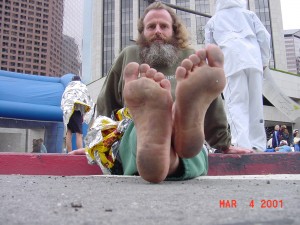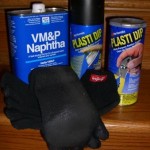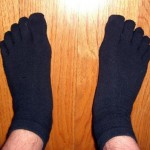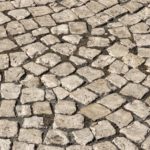Summary
Many people call me a zealot, and I wouldn’t disagree. I run barefoot: BARE FOOT, not in so-called “barefoot shoes”!
In 2005, Nike gave me a pair of Nike Frees to evaluate, and ran in them for less than a mile, wore them once to a restaurant, then I gave them away. I have little need for footwear, especially for running! But that doesn’t mean I haven’t thought about putting some protection on my soles.
When I could see worn spots on the balls of my feet in the weeks before my first barefoot road marathon in January 1999 (I had completed one road marathon in shoes a decade before, and another marathon and a 50K, both barefoot on trails in 1998), the idea of painting rubber cement on the balls of my feet – did cross my mind. But, I am also a procrastinator. Instead of trying to repair my feet, I simply ran even more gently, which got me through the marathon in personal record time, and with no apparent damage to my soles.
But, I do live in Southern California where it rarely gets below the 40s (Farenheit).
Story
Dave Wright, a New Orleans architect, started running at age thirty-three in 1998, built up quickly, and completed a couple of marathons. But by 2003, wracked by a painful iliotibial band, he started doing some research. “I saw that the fast guys were using racing flats,” he says, “so I dumped my big cushions, did New York pain free that fall, and qualified for Boston at Chicago at 3:14 in 2004.
“But by then I developed a bad case of plantar fasciitis. That was the last straw. I decided to go full-time barefoot.” Trouble is, Dave was living in North Carolina, where it gets to 24ºF (-4ºC) in winter.
I came across Plasti-Dip, a flexible, waterproof polyurethane paint used for coating metal
tool handles.”
To get a proper shape, he had to paint it on the sock while wearing the socks and sitting
outside for 45 minutes, trying not to breathe the fumes. He experimented with different types—
cotton, nylon, polyester—before settling on a super-thin, skin-tight model that didn’t shift around on his foot. He made four pairs of gray socks with black Plasti-Dip, all washable and re-coatable.
“It wasn’t exactly barefoot, but still way thinner than Vibrams,” he says. “And the reaction from other runners was almost the same as being barefoot.”
He used the sock runners until the weather warmed, then switched to barefoot.
Related Links
Products
Gallery
- 2005 Boston Sock Racer-bottom
- Sole cutout at ball
- David’s Injinji Sock w/Plasti-dip bottom
- Sock coating product
- David’s Injinji Sock w/Plasti-dip Top
- 2005 Boston Sock Racer-top
- What Ken Bob’s soles look like after a Marathon (2001 March 4) Los Angeles CA











I scraped some skin off my pads/forefoot last week during a five mile run. Temp was 25 degrees. Very disappointing because I ran several times this past winter when temps were in the upper 30’s with no skin damage to my feet. Is this common at temp’s below freezing?
Just started barefoot running. I keep hearing that this will heal my PF which I have suffered with for a few years. After running Boston in 2011 it just got worse and I have not really run since. Is it okay for me to run barefoot even if I still have PF? Nothing else seems to work whether it is orthotics, Massage, physio, injections in the heals,tec, etc. P.s. It’s not just PF, I also have heal spurs.
The most important thing, if you already have injuries or pain (or even if you don’t), is to listen to your body. Don’t just go out and commit to running a certain distance at a certain pace, no matter how you feel. Go out (or stay in) and, especially when you’re first starting to run/walk/stand barefoot, PLAY, LEARN, EXPERIMENT. Figure out how to stand, and lift your feet one at a time in a way that doesn’t aggravate (cause pain to) your injury. LISTEN to how your body feels, before continuing a type of activity or movement that hurts.
The most important reason barefoot running helps people LEARN to run/walk/move/stand more gently, efficiently, and gracefully is the feedback from the soles. And the best place to get more feedback is on a hard, rough surface. If you live where it’s very cold, that’s fine. You shouldn’t be running any kind of distance until you’ve figured out how to move in a way that won’t cause injury or aggravate existing injuries. So you can play barefoot in the house to begin with. If you have space, make a shallow box of sand and sharp stones, or buy a acupressure mat to stimulate your soles and teach you how to distribute your weight over the entire sole – a 200-pound body supported by 100 points, only has 2 pound of pressure on each point (a good thing). A 200-pound body supported by only 10 points has 20 pounds of pressure on each point (not a good thing).
To get a little head start on which basic techniques seem to work for most people (from there you get to fine-tune especially for your own body), read here:
https://barefootrunning.com/?page_id=109
Question about “plasti dip” socks technology:
If I have a sock on my foot, and put “plasti dip” on it, and wait 45 minutes for it to harden, – how then I can detach it from the skin? Should I apply some oil, or soap to the skin, so that I it will not be glued to the sock permanently?
—
Sergey Ivanov.
Though I think most of the dip will stay on the outside of the sock, I would definitely coat my feet with petroleum jelly or some such oil or grease to be sure the dip doesn’t stick to my foot.
Thanks, I did it.
Injinji Performance-Series Lightweight Mini Crew Toesocks, – the thinnest ones, cost $10. Can with Plasti-dip $7. While socks on the feet, soaked the soles with plasti-dip with kitchen sponge. Waited half an hour and repeated with second layer. When dry, took off my feet. I would not recommend coating feet with petroleum jelly, – it does not make a difference. Plasti-dip get to the skin, but it’s very easy to take it off. Manufacturers say it can be easily detached from almost any surface.
I like these “shoes”. I used them, – I don’t like the feeling of the salt under my skin. Here in Maryland the roads are salted, and I see much more salt than snow. Although they do not save me from the nails of dog roses.
Or you know… just put the feet in plastic bags & put the socks over-top of the plastic bags, then apply the plasti dip (for socks that aren’t waterproof)
There are waterproof socks to buy like Dexshell Coolvent Waterproof Socks…
http://www.amazon.com/dp/B00IS5RHB4
I don’t support getting socks that have wool (animal products) in them
Thanks for the article. Recognizable: warming up then get rid of protection!
Would like to share a barefoot experience eventually leading to an ‘invention’ also: The Balloon 🙂
I choose to continue barefoot-training in the last Winter. Some frostbite was the result. Training in continued cold weather, while recovering is not the problem: the ground is hard, no liquid dirt. Now as the weather dissolves into spring, it starts to shift from dry to wet resulting in mud and liquid dirt. I would like to share my balloon solution: seal the affected toe and keep on training.
And thank you for an inspiring website!
Pictures frost bite recovery (If you want to see: some people may find exposed blisters intimidating. Please note it is about recovery, without treatment, while training barefoot continues: http://www.bartvanbroekhoven.com/index.php/nl/pictoronies/12-photo/187-foto-op-17-03-13-om-1314-5
I have run barefoot a few times but because I have hyperhidrosis (excessive and constant sweating of the feet) I have literally slipped a few times because of this and things stick to my feet which don’t stick to my husband’s (we run barefoot together). Everyone keeps saying it’s not as good to not go completely barefoot but all I am feeling is frustrated! It is very uncomfortable for me to not run in something where I can at least absorb some of the sweat. Advice please! What should I do??
It isn’t “as good” to not go barefoot. It’s harder to learn, it’s (For some of us) uncomfortably sweaty, etc., etc., etc. Still, in some conditions it’s going to be more comfortable to wear some sort of footwear – though keep in mind, that comfort can be deceptive, it’s easy to slip into unsafe running habits/techniques if we’re comfortable no matter how we run. The idea is to go barefoot at least often enough to learn and maintain safe running technique. What is safe running technique? Basically, it’s a technique that doesn’t over-stress our body. and because all those stresses pass through the soles of our feet, it’s literally more “sensible” to run barefoot as often as practical, and in a way that is comfortable.
Now, that said, if you’re slipping, it may be that you’re also running in a way that is dangerous. If you’re feet are slipping forward on landing, then you’re probably landing with your foot too far in front of your body. If your foot is slipping backwards, you’re probably trying to push-off (no need to try, that’s why we have springs, more on that if you follow the link below), if your feet are slipping to the sides, then you’re not landing with your center of balance over your foot (also more on that if you follow the link below).
The idea is that anything uncomfortable for your bare soles (even slipping and sliding) is an indication that you can probably improve your technique more.
More info:
http://how.barefootrunning.com
@ Devin. You say you ran “a few times”; an advice that comes to my mind is ‘built from the start’ — go find sand, a beach preferably — go ‘surf running’. The water will cool your feet, the sand provide both steady standing-ground and resistance — making training more heavy and effective 🙂 Built from there. Trick is to built both strength and sensitivity, because you need both to develop your technique — as Ken Bob Saxton writes: “The idea is that anything uncomfortable for your bare soles (even slipping and sliding) is an indication that you can probably improve your technique more.”
I do NOT recommend beginning running barefoot on sand. It is nearly as deceptively comfortable to pound your feet into soft sand as it is with cushioned shoes. The pounding isn’t as easy to sense with the bare soles, so we aren’t necessarily prompted to make a change in our technique.
Secondly, there’s the Barefoot Running Exuberance Syndrome (BRES or Too much, too soon), which a soft comfortable surface also encourages.
I do NOT encourage running too much too soon, until your technique is ready for those distances, in which case it will no longer be too much too soon.
Instead, begin on a really rough surface, where it will be extremely uncomfortable, and then only stand, walk, or run for a few steps at a time, until you figure out how to change the way you are standing, walking, or running so that it isn’t so uncomfortable. Only after you have mastered a few steps on rough terrain, will you be ready for actual barefoot running.
More info:
http://How.BarefootRunning.com
As far as things sticking to the feet, that is not unusual for a beginning barefoot, since the skin is soft and more doughy. Perhaps your feet will begin to sweat less as you go barefoot more often, perhaps you could try wearing less other clothing? As society, and laws permit, of course.
Again, as I’ve said, barefoot running is a great tool for learning. But, no one should be made to feel that barefoot is the only way they will ever be able to run for the rest of their lives. Sure, of course it is the best way to run… but not necessarily at all times, in all conditions, for all individuals.
These comments will probably befuddle those who think of me as a “purist”… I only run barefoot, because I live in an area that is nearly always conducive to barefoot running, beautiful Southern California at the beach! (But, I only rarely run on the soft sand)
Bare in mind that the beach in the ‘sea-sand-crossover-area’ isn’t soft; it is a mud-like substance. It provides a solid layer to go on. In my experience: it is as a water-cooled athletics track. Go slow and find the flow of the sea, discovering a track underneath. Baring in mind also to search for a flat underground. ‘Sloping sand’ as is found on many beaches is very uncomfortable and introduced injuries. ‘Our’ Dutch North sea beach is one of the greatest beaches I know — stretching as far as the eye can see. Generally flat and wide. But I have never been in Southern California for that matter. And am drifting off the topic…
Bare in mind that I live at the beach. In fact I will be going for a low-tide run later today.
Again, this is a very deceptively comfortable place to run. It is not as hard as it appears, about as hard, as you say, a rubber track, or a cushioned shoe.
There is just enough give to reduce the feeling that we are not landing with much impact, without actually providing enough cushion to absorb the actual impact. We may feel “gentle” when in fact we may well be landing with much more impact than we would while barefoot on a concrete or asphalt surface, or gravel trail.
Think of the beach, grass, rubber race tracks, and other “barefoot friendly” surfaces like dessert. They’re very tasty and sweet, but without good nutrition, they can destroy your body.
Looks like a fun running event, enjoy!
My yesterday run took me over all the undergrounds you describe — going from hometown Haarlem trough the Kennemerduinen, to- and on the beach to IJmuiden and back, in a relaxed 2 1/2 hour run (barefoot). Every part of the landscape introduces its own rhythm. To me it is an intuitive ‘flow’. I run since the age of 11, running now for 30+ years. When living on the beach in 2001 starting to go barefoot there building it up towards being able to adapt to all different undergrounds — although small stones on asphalt for example remain cumbersome but not undoable. I just love to go barefoot and am surprised and amazed every run how much fun it is — despite the small, natural inconveniences.
I would be interested to know: going back to the question as raised by Devin above, do you think someone suffering from hyperhidrosis would benefit from running trough water?
There are different benefits of running on each kind of terrain. Running in the water, of course, helps cool the feet and make them more comfortable – if they are hot to begin with.
But beach sand is one of the worse places for beginning barefoot runners, despite what other “experts” may have told us. On a soft surface anyone can run barefoot, with almost any kind of technique, with practically no idea that they are injuring their body in the long term – until AFTER they have done enough damage to sense the pain in their knees, back, ankles, hips, etc..
On rougher terrain, the bare soles let us know immediately, emphatically, with each and every step, as soon as we need to change our technique to eliminate the stresses that injure us over time.
This is precisely the reason our bare soles have so many nerves and are so much more sensitive, because they are our first line of defense against injurious running technique.
Great! Thanks for sharing this. When trained the bare soles “… let us know”, as you say: “… immediately, emphatically, with each and every step, as soon as we need to change our technique to eliminate the stresses that injure us over time…”, something shoes can not accomplish so ‘sharp’ . The bare soles (instrumented with “many nerves”) can help us navigate trough the different terrain, as part of an adaptable way of life (as opposed to shoe-straight-forward running, with all due respect). Making a trained barefoot runner fast and happy — against all odds.
Mr. Bob,
My military hat off to you. YOu are my new Idol. I am a runner and have been for the past 10 yrs. I am in the military and for a stress reliever I run and have made it my hobby. People ask me how do I do it? I say that it takes my mind into a world where the horizons are as far as you want them. I know that running on a treadmill isn’t good for running barefoot, but at 1130 almost everyday, since I arrived to Germany, I go to the gym and run for about 45 min. to an hour. But the moral of this story is that while I run, I read and listen to music. I read the greatest two books in the last 3 months while running, BORN TO RUN and STEP BY STEP RUNNING BAREFOOT :). I know that running in Vibram shoes is not the right thing to do but at night I run out in my village and I am building courage to run barefooted in the near future,so I will do the Plastidip socks idea and see how that feels and then eventually take off barefooted. I have to admit though , that I have been using your bent knee technique and it has been better for my hips and knees yay !!!!!!
I would encourage you to, in addition to, or instead of, but preferably at the beginning of your runs, especially in minimalist footwear (which does not provide the support your feet may be used to), run a short distance on a stimulating surface to remind you of HOW to run barefoot. Then try to continue your run, running as if you were barefoot, in whatever footwear you choose.
The downside of starting with minimalist footwear, as I allude above, in my book, and constantly on my website, is that you cannot sense immediatly with each and every step, how much stress and strain you’re putting on your feet, which often leads to people literally breaking their feet.
Do NOT try to run up on the forefoot, and do TRY to relax, and allow your entire sole to touch the ground. Let your knees bend to reduce all of those stresses and strains which injure runners.
more info: http://how.barefootrunning.com/
I have only been walking (2-3 miles/day) bf 2 months and running (< mile each time)1-2 weeks. I did discover something that is handy as a "warning" bell. When you strike, the vibration of your bones can be heard really well if you're wearing full headphones with the music shut off. I run a little with forefoot strike but my calves get tired so I do a "side / mid" foot strike for a while…it feels gentle on the feet but my headphones deliver a "clomp clomp" with this strike vs. almost complete silence with the ball of foot strike.
Ear plugs may give a similar effect. Blocking out the external noises, the internal noises get transmitted through our bones. Unfortunately, this also blocks out the sound of a truck driving up behind us, or a bear running after you, etc..
Alternatively, short bits of practice on rough terrain, or gravel will give a more emphatic sensation in the bare soles when using poor technique.
Thanks Ken,
I do notice occasionally I’ll hit this stride where it feels like I’m barely touching the ground. As soon as I think about it, it’s gone! I look forward to being able to run virtually anywhere. I’m hooked. I’m experiencing anxiety now that I know winter is coming here in Central Maine (picture the exact opposite of SoCal!)
Play around, particularly, think about running and walking as moving the body forward, not so much about using the legs to move it forward. Now move your body forward (torso still vertical, knees still bent), and let your legs follow. Move your feet quickly, especially on the lift. This is where you should find the light steps – what I like to call, “lifting the foot before it lands”.
This sounds a bit impossible, and as if you could do this, then your feet would never touch the ground??? But, isn’t that the direction we want to be heading, almost to that point anyway, where the feet are just barely touching the ground.
The idea is that pulling the foot “up” before it touches, doesn’t actually pull it up relative to the ground, it pulls it up relative to our body, which is falling toward the ground. If one begins pulling the foot up early, one is actually merely slowing it’s descent toward the earth, like hitting reverse on the space shuttle just before it docks with the space station. (after all, we wouldn’t wait until crashing into the space station before we decelerate!)
-Barefoot Ken Bob
P.S. I don’t need much imagination to picture Maine in the winter, since I lived the first 24 years of my childhood (still haven’t grown up yet at age 58) in northwestern lower Michigan, back before global climate change, when it was really cold in the winter. Except it is less rocky in lower Michigan than in Maine.
Thank you! I was wondering if this would work and a duckduckgo search brought me here. Will buy toe sock instead. Also I’m going to stuff my socks with pillow stuffing wrapped in plastic wrap in order to coat since I have no desire or time to sit outside while my socks dry 🙂 I’ll let you know if it works. These will be for nature tracking in the mountainous desert so here’s hoping they are thorn proof. Thanks again!
It worked! Although I ended up using plastic bags for stuffing since the pillow fluff would have gotten stuck inside the interior. I walked briefly in them on a crisp night and found that my feet are not happy on frozen ground. But no thorns after applying 4 coats. Bonus, the toes are stiff and force my deformed toes to unfold from under my feet. Can’t wait to give these a real try when the weather warms.
Pingback: 自分でミニマリズムを! | キムブログ for Athletes
Ken, surely these socks eventually wear out. I have a pair of All Star socks that I just applied four coats of Plasti-Dip to, and I am wondering how many miles I can get out of these socks before they’re too holey to use.
Of course they wear out, like any other dead product.
Personally, I don’t have much experience with them, since I use my own living soles, which do repair/heal themselves.
However, I suppose you could patch them whenever you get the urge with more plasti-dip. Besides the total cost is pretty cheap compared with similar, and non-custom shaped, “barefoot shoes”.
Have fun!
Also, if you learn to run actually and truly barefoot first, you should be running gentle enough and with very little abrasion, so wear is also minimized that way. However, if you’re using these to protect your soles from the pains caused by poor running technique, they won’t last long at all.
I was just banned from barefoot running at the indoor track I use when it is snowing and/or below freezing outside. So I am thinking, flesh colored, five toed versions of these till the thaw.